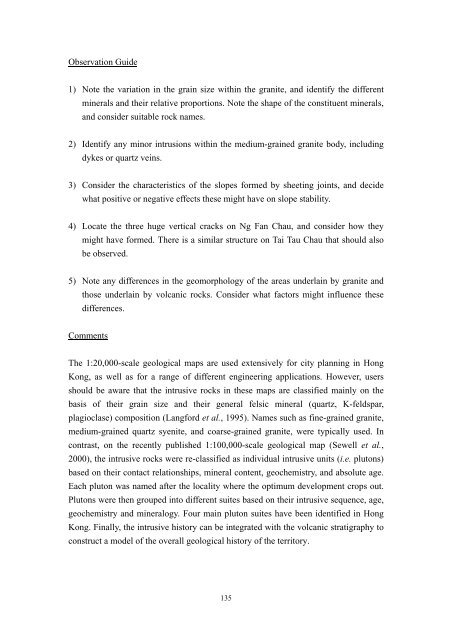Hong Kong Geology Guide Book Geotechnical Engineering Office ...
Hong Kong Geology Guide Book Geotechnical Engineering Office ...
Hong Kong Geology Guide Book Geotechnical Engineering Office ...
You also want an ePaper? Increase the reach of your titles
YUMPU automatically turns print PDFs into web optimized ePapers that Google loves.
Observation <strong>Guide</strong><br />
1) Note the variation in the grain size within the granite, and identify the different<br />
minerals and their relative proportions. Note the shape of the constituent minerals,<br />
and consider suitable rock names.<br />
2) Identify any minor intrusions within the medium-grained granite body, including<br />
dykes or quartz veins.<br />
3) Consider the characteristics of the slopes formed by sheeting joints, and decide<br />
what positive or negative effects these might have on slope stability.<br />
4) Locate the three huge vertical cracks on Ng Fan Chau, and consider how they<br />
might have formed. There is a similar structure on Tai Tau Chau that should also<br />
be observed.<br />
5) Note any differences in the geomorphology of the areas underlain by granite and<br />
those underlain by volcanic rocks. Consider what factors might influence these<br />
differences.<br />
Comments<br />
The 1:20,000-scale geological maps are used extensively for city planning in <strong>Hong</strong><br />
<strong>Kong</strong>, as well as for a range of different engineering applications. However, users<br />
should be aware that the intrusive rocks in these maps are classified mainly on the<br />
basis of their grain size and their general felsic mineral (quartz, K-feldspar,<br />
plagioclase) composition (Langford et al., 1995). Names such as fine-grained granite,<br />
medium-grained quartz syenite, and coarse-grained granite, were typically used. In<br />
contrast, on the recently published 1:100,000-scale geological map (Sewell et al.,<br />
2000), the intrusive rocks were re-classified as individual intrusive units (i.e. plutons)<br />
based on their contact relationships, mineral content, geochemistry, and absolute age.<br />
Each pluton was named after the locality where the optimum development crops out.<br />
Plutons were then grouped into different suites based on their intrusive sequence, age,<br />
geochemistry and mineralogy. Four main pluton suites have been identified in <strong>Hong</strong><br />
<strong>Kong</strong>. Finally, the intrusive history can be integrated with the volcanic stratigraphy to<br />
construct a model of the overall geological history of the territory.<br />
135

















